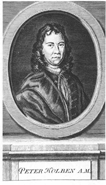KOLBEN, PeterProfessional Astronomer |
|
|
|
|
| Famous for: Kolben was the first official astronomer at the Cape (thus in South Africa) . Summary: |
|
|
|
|
| History: In 1705 Baron Krosick, who was Kolben’s patron, dispatched two astronomers. Both astronomers were to make complementary observations in order to measure the distance to the moon. One of the astronomers was sent “somewhere north”, and Kolben was sent to Cape Town. Apart from the moon project, Krosick ordered Kolben to determine the Cape’s geographical position (longitude), as well as to study the natural history of the Cape. Kolben was very unpopular with the local Government at the Cape, Governor Willem Adriaan Van Der Stel. The reason was that Kolben loved smoking, drinking, gossiping, and forwarding letters of complaint to Europe. (W. A. Van Der Stel was found guilty of appropriating the farm Vergelegen, and dismissed after a Court of Inquiry. In the period leading to his dismissal, whilst still Governor, Van Der Stel attempted to keep his activities from the authorities namely the Dutch East India Company in Amsterdam. Therefore certain letters (especially letter of complaint against him) got lost if it was posted through the official channels. Kolben was able to bypass the system, and so helped to lead to the down fall of the Governer. ) Kolben enjoyed the Cape and did not do too much work. “… but after five years experience of him the Governor of the Cape of Good Hope inscribed the following Resolution: “The Astronomer, Pieter Colbe, who arrived here in the year 1705, in the ship called the Unie from Holland, and who has for a considerable time been idling about without prosecuting his astronomical observations or rendering any burgher-service . . . it was thought advisable to demand from him whether he intends to remain here much longer in which case he will be considered as a burgher, and thus become liable to taxes and burgher-duty; otherwise we shall give him his discharge so that he may return to Europe.’ The thought of going back to Europe and leaving the pleasures of the Cape behind him does not seem to have appealed to Kolbe, and he obviously chose to stay, as we next heal of him in Stellenbosch, occupying the post of secretary to the Court of the Landrost of the Heemraad”. [Copied from Moore pp. 27 – 28.] . Career: 1705 to 1713: Cape Colony. . Personal: He liked to smoke, drink and gossip. |
|
|
|
|
|
Link to the Telescope Manufacturers. |
|
|
|
|
|
Link to the Main Bibliography Section and more information about Sources. |
|
| Remaining Artifacts: Painting: Moore, p. 27. Reference to Africana Museum. Site: His Observatory was situated in the Buren Bastion at the Castle of the Cape of Good Hope. There is no record that he actually did observations. . Bibliography: Gunn, M. & Codd, L.E., Botanical Exploration in Southern Africa, Balkema, 1981. Moore, P. & Collins, P., Astronomy in Southern Africa, pp. 26 – 28. (General Source) . By Kolbe: Kolben wrote a book on the Natural History of the Cape in 1719. Apparently it created quite a stir when it was translated from the German into English in by Medley in 1731. Some of the information was imaginative and rather incorrect. [Moore, p. 27; Gunn] . Archival: SOUTH AFRICAN ARCHIVES, ROELAND STREET, CAPE TOWN [JHA8, p. 220.] -This is the principal depository for all the early Government records and thus contains official correspondence concerning the visits of Kolbe and Lacaille. |
|
|
|
|


